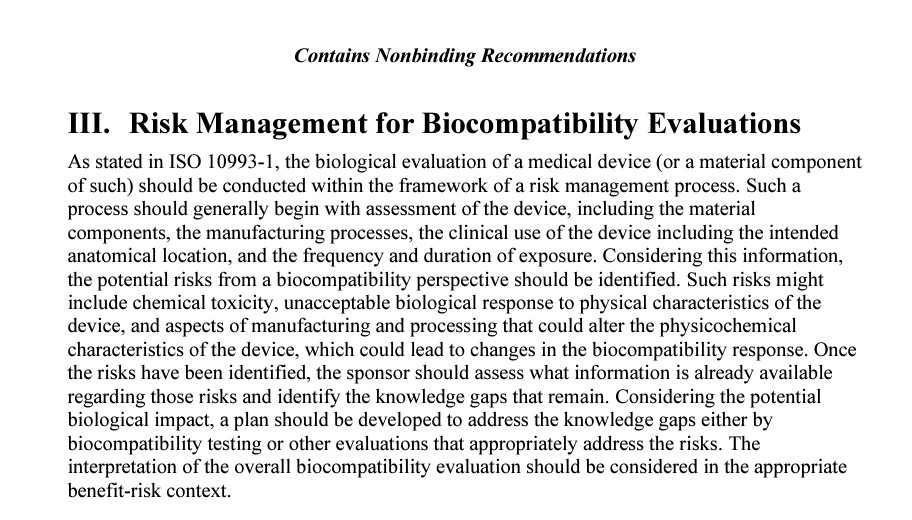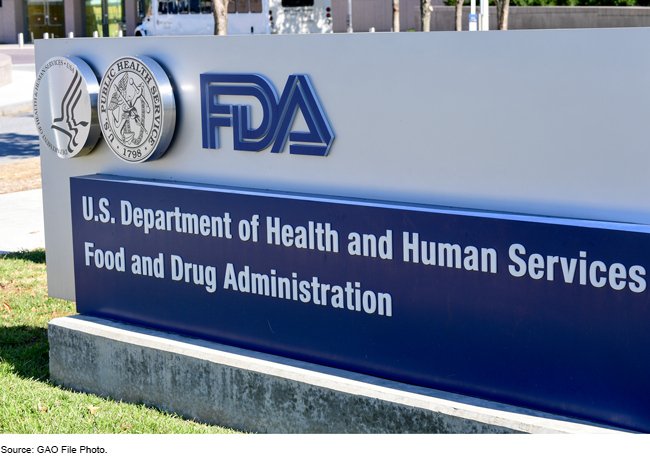Insights on Risk Management for Biocompatibility Evaluation
The FDA Guidance on Using ISO 10993-1 emphasizes the importance of incorporating a risk-based approach to biocompatibility evaluation throughout the medical device lifecycle. Biocompatibility evaluation is a critical component of ensuring the effectiveness and safety of medical devices.
This article delves into the recent FDA Guidance on Using ISO 10993-1 integrating biocompatibility evaluation within the risk management process, as outlined in the FDA Guidance Document Use of International Standard ISO 10993-1, Biological Evaluation of Medical Devices Part 1: Evaluation and testing within a risk management process.
“FDA has developed this guidance document to assist industry in preparing Premarket Applications (PMAs), Humanitarian Device Exceptions (HDEs), Investigational Device Applications (IDEs), Premarket Notifications (510(k)s), and De Novo requests for medical devices that come into direct contact or indirect contact with the human body in order to determine the potential for an unacceptable adverse biological response resulting from contact of the component materials of the device with the body.”

Device Risk Assessment
The FDA Guidance on Biocompatibility Evaluation ISO 10993-1 takes into consideration that the risk assessment should evaluate the product in its final finished form. Key considerations include:
- Materials used
- Material processing methods
- Manufacturing techniques
- Proposed clinical use of the medical device
- Intended anatomical location (for example, intact skin, mucosal membrane, tissues/ bones etc)
- Duration of exposure to the device (material components having direct or indirect contact with the skin, intermittent or continuous exposure)
- Target population
Recognizing Potential Risk
Biocompatibility risks extend beyond chemical toxicity to include physical characteristics that might induce unwanted tissue responses. Some of the key physical characteristics that can be assessed to identify the risks are:
- Geometry of the device
- Mechanical, thermal, and electromagnetic forces on surrounding tissue
- Surface properties
The FDA advises monitoring changes in manufacturing and processing parameters, as these can impact biocompatibility. Sources of information for assessing the potential risks associated with biocompatibility can include —
- Manufacturer’s previous experience using the similar material and anatomical locations.
- Experience of other manufacturers using the same material in the similar anatomical locations
- Information provided by other suppliers.
- Published literature.
Using data from previous experiences is most relevant when the tested device closely resembles the new device in terms of its intended use and material composition.
Additionally, chemical analysis of the device in its finished form is crucial for evaluating long-term toxicity, although it should be supplemented by assessments of the device geometry and surface properties.
Mitigating Risks by Considering Available Information
To avoid unnecessary testing, including animal testing, the FDA Guidance on Biocompatibility Evaluation ISO 10993-1 recommends making efficient use of all the available information that is of relevance while conducting the assessment.
The FDA suggests that the following information should be considered while assessing the risk, if applicable:
Literature and Public Information
Sponsors should review existing literature and relevant information to identify specific risks and mitigation measures.
Sponsors are advised to be specific and selective while choosing the relevant literature and information available for risk assessment. It is important to evaluate the relevance of such information, particularly regarding manufacturing and processing. Clinical data becomes less relevant if there are changes in the material of the medical device.
Clinical experience
Incorporating clinical experience into the biological evaluation process enhances the understanding of device biocompatibility and contributes to the development of safe and effective medical devices.
However, clinical experiences may not always provide sufficient biocompatibility information as the data can often be too broad and general.
Animal study experience
Non-clinical animal studies can provide initial evidence of device safety and performance. Results obtained from relevant animal models while assessing for biocompatibility endpoints can be used, but additional tests may be necessary if adverse biological responses are observed. The FDA may require further evaluation beyond animal testing.
Consensus standards
Consensus standards are valuable for assessing the risks which are specific to the material of a device or a particular device. The relevance of these standards depends on the specificity of the material and device being analysed.
Devices previously reviewed by FDA
Experiences with devices previously reviewed by the FDA are particularly useful for risk assessment. This information is more relevant when the devices have been reviewed by the same sponsor, as manufacturing and processing details from other manufacturers may be unknown.
Submission and Interpretation
When submitting to CDRH or CBER, sponsors are required to provide their risk assessment at the beginning of the biocompatibility section.
According to the FDA Guidance on Biocompatibility Evaluation ISO 10993-1 outlined in “Biological Evaluation of Medical Devices Part 1: Evaluation and testing within a risk management process”, the sponsor should include:
- A clear summary regarding the risk assessment.
- An explanation of the relationship between the identified risks and the information available to mitigate any risks.
- Identification of any knowledge gaps.
- An explanation of any toxicities and adverse effects identified in their biocompatibility testing or other evaluations.
Sponsors are encouraged to share any additional information to enhance the assessment effectiveness.
Final Thoughts
In summary, the FDA Guidance on Using Biocompatibility Evaluation ISO 10993-1 recommends a risk-based approach while conducting Biocompatibility assessments. By considering all the relevant parameters and sources of information, this FDA guidance helps sponsors navigate and develop a robust biocompatibility strategy, facilitating the development and approval of safe and effective medical devices.
For more information on medical device biocompatibility, check out these StarFish Medical blogs A design engineer’s perspective of medical device biocompatibility and Food-Grade vs Biocompatibility for Medical Device Materials.
Vinky Kohli is a Quality Assurance and Regulatory Affairs Specialist in StarFish Medical. Vinky has done her Master of Engineering in Biotechnology and has experience in Pharma and medical device industries in QA/RA, product development, QMS development and maintenance. Vinky has passion for quality work including documentation.
Images: FDA.gov
ELLA is a free AI-powered FDA regulatory research tool that uses advanced natural language processing to extract key insights from FDA databases, guidance documents, and adverse event reports.
Designing a medical device, but not sure whether it needs to be biocompatible? Check out A design engineer’s perspective of medical device biocompatibility.
Learn more: Is Anodized Aluminium Biocompatible?

